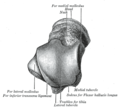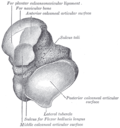Talus bone
Talus Bone
The Talus bone or ankle bone is one of the group of foot bones that transfers weight and forces between the lower limb and the foot. It is a short, stubby bone that is located between the tibia and fibula of the lower leg and the calcaneus (heel bone). The talus bone is an integral part of the ankle joint and the subtalar joint.
Anatomy[edit]
The talus bone is irregularly shaped and can be divided into three main parts: the body, the neck, and the head. The body is the largest part and is located posteriorly. The neck is the narrow, oblong section that connects the body to the head. The head is the rounded, anterior part of the talus that articulates with the navicular bone.
Function[edit]
The primary function of the talus bone is to serve as a connection between the foot and the leg, allowing for the transfer of weight and forces. It also plays a crucial role in foot movements such as walking, running, and jumping. The talus is unique in that it is the only bone in the body that has no muscular attachments, relying solely on ligamentous connections for stability.
Clinical Significance[edit]
Injuries to the talus bone, such as fractures or dislocations, can be serious and potentially debilitating. Due to its unique blood supply, the talus is particularly susceptible to avascular necrosis (death of bone tissue due to a lack of blood supply) following injury. Treatment of talus injuries often involves surgery and a lengthy recovery period.
See Also[edit]
-
Foot Anatomy
-
Subtalar Joint
-
Talus bone
-
Talus bone
-
Os trigonum
-
Talus bone animation
-
Talar Fractures
-
Talus - inferior view
-
Ankle
-
Talus bone
-
Talus bone
Ad. Transform your life with W8MD's Budget GLP-1 injections from $75


W8MD offers a medical weight loss program to lose weight in Philadelphia. Our physician-supervised medical weight loss provides:
- Weight loss injections in NYC (generic and brand names):
- Zepbound / Mounjaro, Wegovy / Ozempic, Saxenda
- Most insurances accepted or discounted self-pay rates. We will obtain insurance prior authorizations if needed.
- Generic GLP1 weight loss injections from $75 for the starting dose.
- Also offer prescription weight loss medications including Phentermine, Qsymia, Diethylpropion, Contrave etc.
NYC weight loss doctor appointmentsNYC weight loss doctor appointments
Start your NYC weight loss journey today at our NYC medical weight loss and Philadelphia medical weight loss clinics.
- Call 718-946-5500 to lose weight in NYC or for medical weight loss in Philadelphia 215-676-2334.
- Tags:NYC medical weight loss, Philadelphia lose weight Zepbound NYC, Budget GLP1 weight loss injections, Wegovy Philadelphia, Wegovy NYC, Philadelphia medical weight loss, Brookly weight loss and Wegovy NYC
|
WikiMD's Wellness Encyclopedia |
| Let Food Be Thy Medicine Medicine Thy Food - Hippocrates |
Medical Disclaimer: WikiMD is not a substitute for professional medical advice. The information on WikiMD is provided as an information resource only, may be incorrect, outdated or misleading, and is not to be used or relied on for any diagnostic or treatment purposes. Please consult your health care provider before making any healthcare decisions or for guidance about a specific medical condition. WikiMD expressly disclaims responsibility, and shall have no liability, for any damages, loss, injury, or liability whatsoever suffered as a result of your reliance on the information contained in this site. By visiting this site you agree to the foregoing terms and conditions, which may from time to time be changed or supplemented by WikiMD. If you do not agree to the foregoing terms and conditions, you should not enter or use this site. See full disclaimer.
Credits:Most images are courtesy of Wikimedia commons, and templates, categories Wikipedia, licensed under CC BY SA or similar.
Translate this page: - East Asian
中文,
日本,
한국어,
South Asian
हिन्दी,
தமிழ்,
తెలుగు,
Urdu,
ಕನ್ನಡ,
Southeast Asian
Indonesian,
Vietnamese,
Thai,
မြန်မာဘာသာ,
বাংলা
European
español,
Deutsch,
français,
Greek,
português do Brasil,
polski,
română,
русский,
Nederlands,
norsk,
svenska,
suomi,
Italian
Middle Eastern & African
عربى,
Turkish,
Persian,
Hebrew,
Afrikaans,
isiZulu,
Kiswahili,
Other
Bulgarian,
Hungarian,
Czech,
Swedish,
മലയാളം,
मराठी,
ਪੰਜਾਬੀ,
ગુજરાતી,
Portuguese,
Ukrainian










